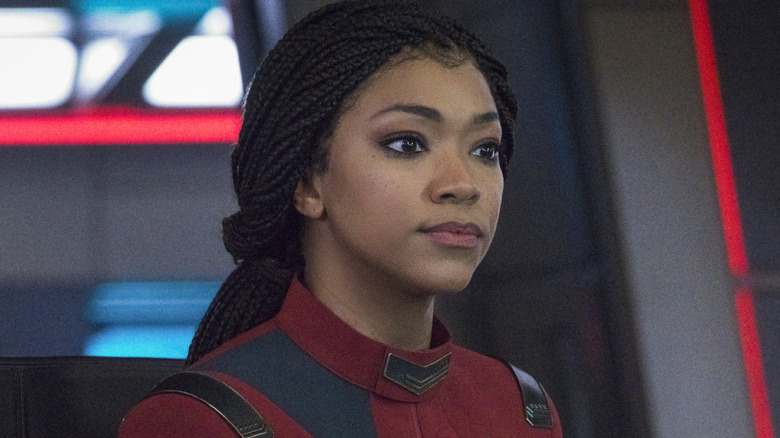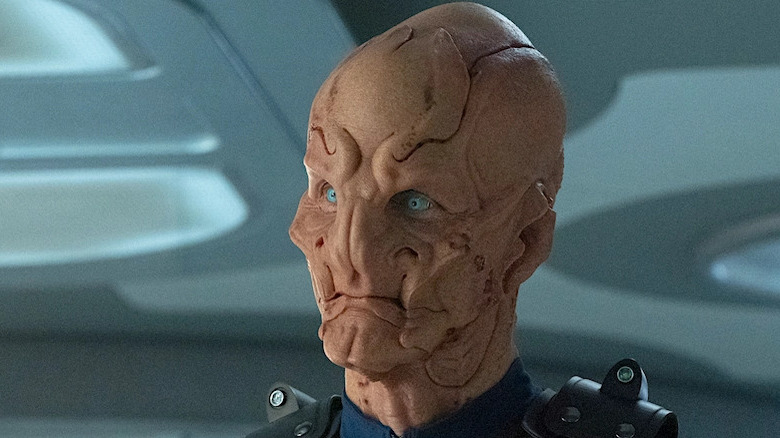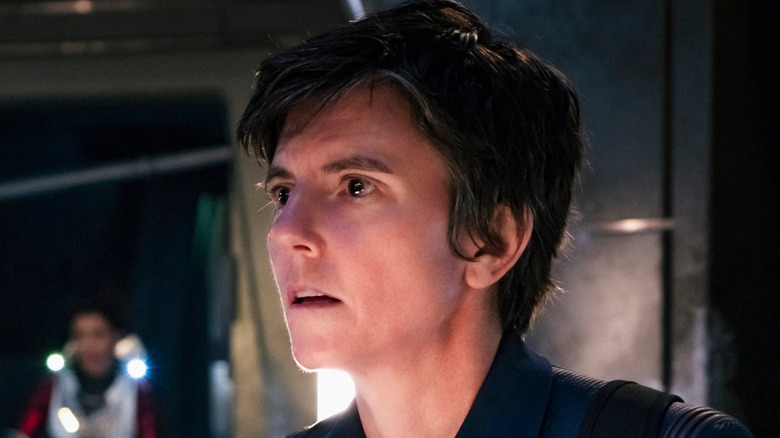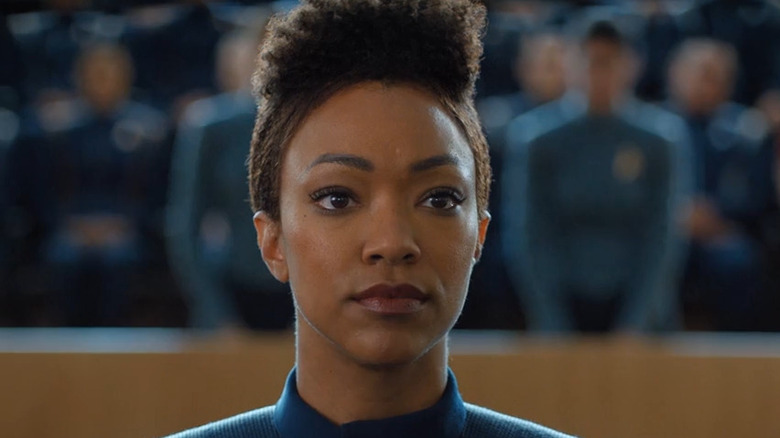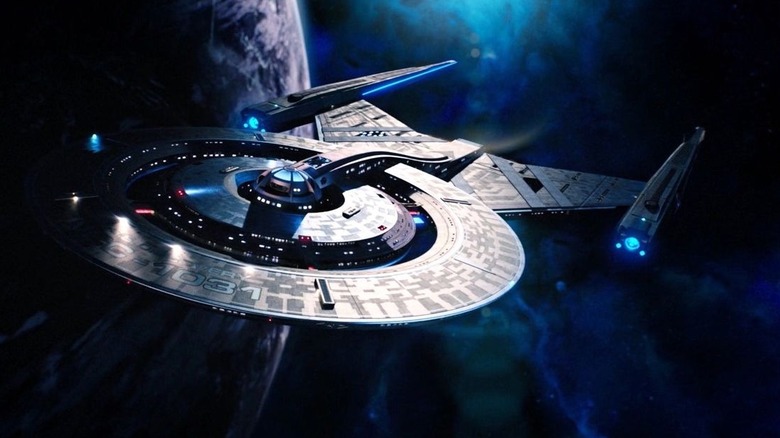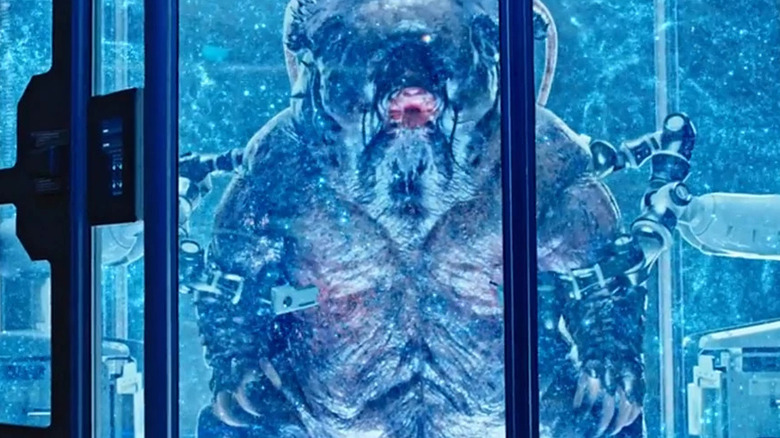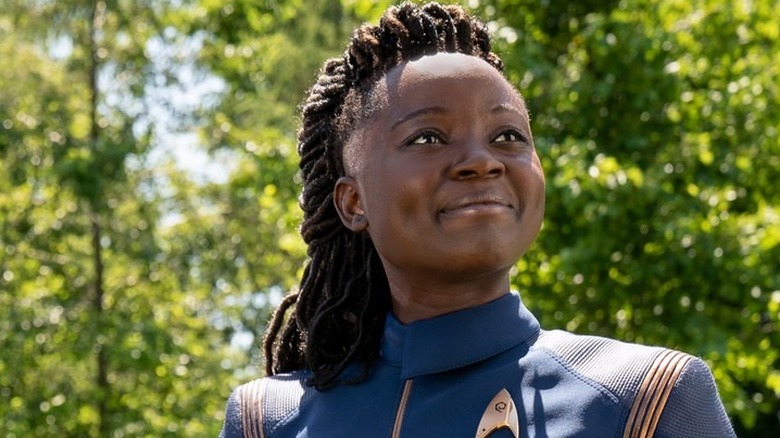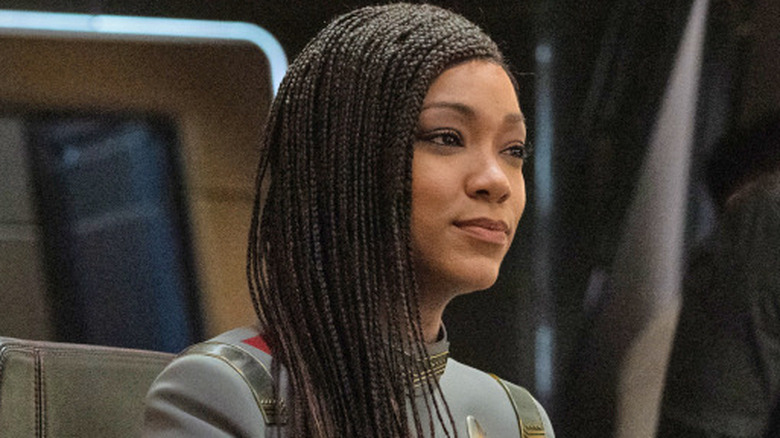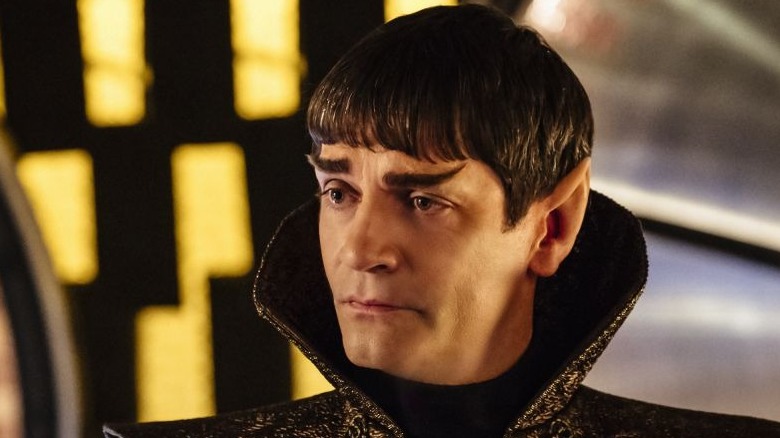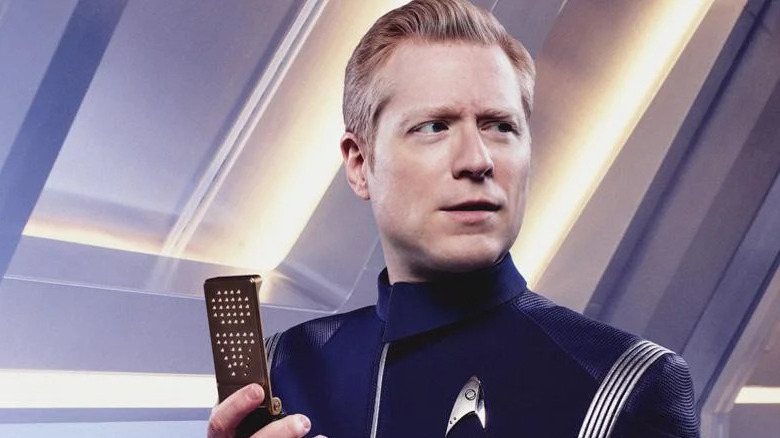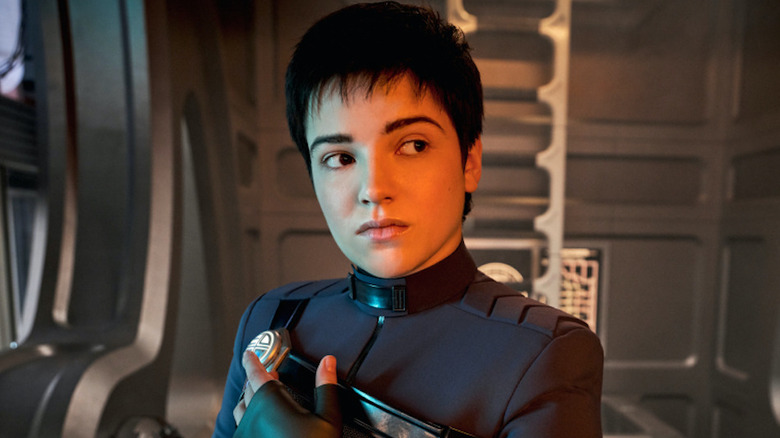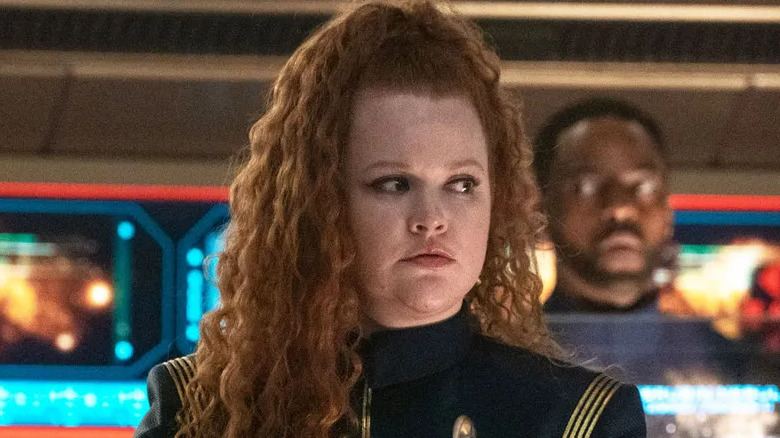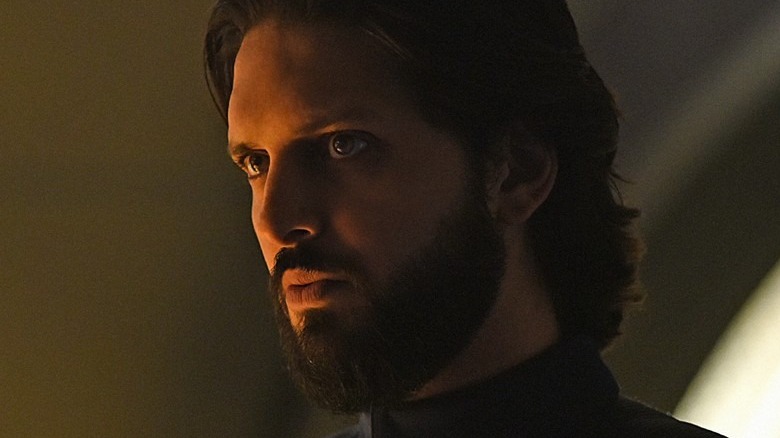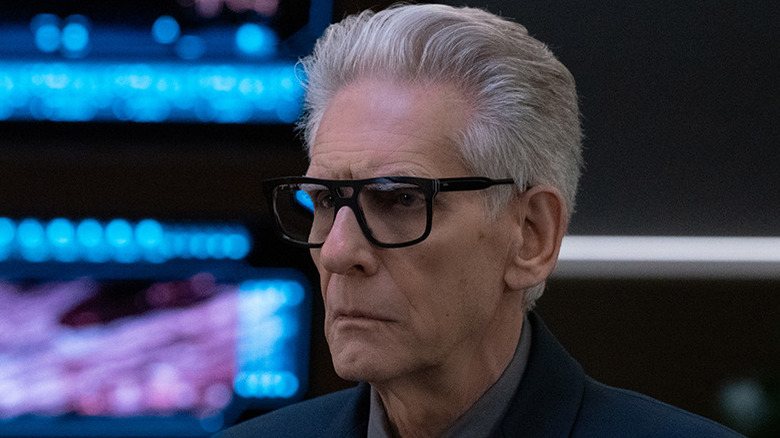The Untold Truth Of Star Trek: Discovery
"Star Trek: Discovery" was the long-awaited return to the small screen for the iconic franchise, debuting in fall of 2017 — twelve years after the sudden cancellation of Scott Bakula's "Star Trek: Enterprise." Upon its release, it was perhaps the most anticipated new "Star Trek" since the first motion picture in 1979, and it proved just as controversial as that first movie, with an updated look, redesigned alien races, and new characters that made fans raise an eyebrow. Audiences have been split on the series since its debut, but there's no denying that it's been a big hit. Its success as a streaming exclusive on CBS All Access (now Paramount Plus) has led to a number of new "Star Trek" projects, including an animated series, and the upcoming spin-off, "Star Trek: Strange New Worlds."
Now on its fourth season, series lead Michael Burnham has completed her journey to the captain's chair and the ship has taken its rightful place in a new United Federation of Planets. Burnham, Saru, Stamets, and the rest of the crew stand ready to defend the galaxy from the latest alien threat in the 32nd century, nearly a thousand years after the era of Kirk and Spock. But how did they get there? It's been a long road, with struggles and challenges along the way — here is the untold truth of "Star Trek: Discovery."
It was created by Hannibal's Bryan Fuller
After the success of the three J.J.Abrams films starring Chris Pine and Zachary Quinto released by Paramount, CBS (which owned the small screen rights to the "Star Trek" franchise) felt the time was right to put together a new series, this time as a streaming exclusive. It wouldn't star the crew of the Enterprise, in fact it wouldn't even take place in that universe. CBS had to find a producer with some bold new ideas, and they turned to one of the most talked-about TV producers in the business for the answers: Bryan Fuller.
Fuller actually had a history with "Star Trek" long before he was a buzzworthy Hollywood producer. Already a huge fan of the franchise, he was hired in the mid-1990s as a contributing writer on a"Star Trek" spin-off series' and would create stories for twenty two "Star Trek" episodes, including the acclaimed "Star Trek: Deep Space Nine" episode, "The Darkness and the Light." Combining that pedigree with his recent hit shows "Hannibal," "Pushing Daisies" and "Dead Like Me" — all critical darlings — and Fuller seemed like the perfect person to get "Star Trek" back into its place as one of television's premier franchises.
It was originally going to be an anthology
One of Bryan Fuller's initial ideas was for this new show to be an anthology series, with different stories told in different time periods. "The original pitch was to do for science-fiction what 'American Horror Story' had done for horror," Fuller told "Entertainment Weekly" in 2017. "It would platform a universe of 'Star Trek' shows."
Even the earliest promotional materials talked about "different ships" and "different crews" which intrigued fans who knew little about the behind-the-scenes discussions and were left to wonder what it meant. While the first season did include a second Starfleet ship, the U.S.S. Shenzou, it's possible those early marketing materials were talking about Fuller's intention to skip around the timeline and show a variety of ships in other eras. Whatever the case, CBS abandoned the idea in order to focus on a single serialized concept. Fuller eventually settled on the show being set just prior to the days of the original "Star Trek" series, and announced the title as "Star Trek: Discovery," using the last NASA space shuttle as inspiration for the name of the title ship. Unfortunately, little else is known about Fuller's true vision for the series, as he would leave the project shortly after it was announced to focus on other projects, and fans were left to wonder what might have been.
Burnham was the hardest role to cast
Co-creator Bryan Fuller has said as far back as 2013 that if he were to create a new "Star Trek" show he wanted to cast Angela Bassett in the lead role. While Basset as a Starfleet captain sounded exciting, there's no evidence it was ever seriously considered. Still, it's clear that Fuller had his heart set on an African American actor — and a woman — to lead his new show. Finding the right actress for the role, however, proved a daunting task.
Fuller early on knew he didn't want a captain to be the central character of his new show, but instead show the journey of a more junior officer and her rise through the ranks to become captain of the U.S.S. Discovery. He needed just the right actor for the part, something producer Alex Kurtzman said was "a tall order." After an exhaustive search described as a "nail-biter," actress Sonequa Martin-Green ("The Walking Dead") was picked to play Michael Burnham. To the producer's shock though, Martin-Green turned down the initial offer due to other commitments, something that she admitted was very disappointing, but unavoidable. Thankfully, when the series was pushed back following Fuller's departure from the series, it allowed Martin-Green the chance to accept the role. Now, as Michael Burnham, she follows in the footsteps of Kate Mulgrew as the franchise's newest woman in the captain's chair.
The ship was based on designs by Star Wars' Ralph McQuarrie
"Star Trek: Discovery" isn't the first time that producers tried to bring the franchise back to television after a series had been cancelled. And it's not even the second. Long before "Star Trek: The Next Generation" brough back the iconic series in 1987, Paramount had tried to produce a series in the late 1970s, just a decade after the end of the original show.
Titled "Star Trek: Phase II," the proposed series would go through a number of different iterations before it finally was turned into the 1979 film "Star Trek: The Motion Picture." Along the way, producers had at one point thought of the new "Star Trek" as a film titled "Planet Of the Titans" and for its visual design they turned to noted film artist Ralph McQuarrie, fresh off of his work on George Lucas' "Star Wars." When producers at CBS were drafting up ideas for a new ship design for "Star Trek: Discovery," they decided to harken back to the unused piece of design work. Inspired by its wedge-shaped secondary hull and low, flat profile, the influence is pretty clear, even with the futuristic upgrades it receives in the third season.
It was involved in multiple copyright infringement lawsuits
"Star Trek: Discovery" would be accused of idea theft since almost the day the show was announced. Alec Peters — a fan turned would-be producer who created a notorious "Star Trek" fan-film that landed him in hot water with Paramount and CBS — accused "Discovery" of infringing on the premise of his film, even before he knew what their new show was about (and despite his own film "stealing" the "Star Trek" property itself, and ultimately not really having much in common with "Discovery"). Paramount/CBS accused Peters of profiting off the fan film — betraying the ideals of the fan film community– ultimately suing Peters for infringing on the "Star Trek" copyrights, leading to an out-of-court settlement.
But that wasn't the end of infringement cases for "Discovery," as it was the target of its own lawsuit from a game developer who claimed that the concept of the ship's warp drive piloted by a tardigrade was stolen from his latest game. After both sides gave their statements it became clear that any vague similarities between the two ideas were merely coincidence, as the game had not been released even when "Discovery" aired and there was almost no conceivable way that the producers of "Star Trek" could have been aware of it. The case was dismissed in 2018, in a decision that was reaffirmed in August of 2020.
Season 3 bears a striking resemblance to Andromeda
The "Tardigrade" lawsuit wasn't the last time the series would be accused of theft, either. At the beginning of the third season, producers retooled the show by sending the U.S.S. Discovery 900 years into the future. There they find the Federation is a shell of its former self, and must help restart the interplanetary alliance. Fans immediately pointed out that this bears a strong resemblance to Gene Roddenberry's other sci-fi series, "Andromeda." The show starred Kevin Sorbo as Dylan Hunt, a starship captain in a prosperous future who is frozen in time for 300 years. When he and his ship re-emerge, they find a galaxy in turmoil, and he attempts to bring peace and order to a chaotic universe.
The story only makes sense; A major change in the status quo was needed to prevent "Discovery" — even a thousand years hence — from being simply the same show it was before. Just as a wormhole and a space station were necessary to shake things up for "Deep Space Nine" or stranding the ship in the Delta Quadrant helped liven up "Voyager," the "fall of the Federation" was an easy galactic reset that helped prevent "Star Trek: Discovery" from getting stale.
They retooled the series to escape continuity
When "Discovery" first launched, fans were certainly mixed on the prequel setting. Some felt it was a good era to explore with more danger and less technology, while others felt it was a time we'd seen enough of and disliked prequels concepts in general. After two seasons set just a decade before "Star Trek: The Original Series," however, the producers took a bold step and essentially rebooted the entire show, catapulting Michael Burnham, Saru, and the crew of the U.S.S. Discovery more than 900 years into the future.
"The idea that the crew had to jump to the furthest timeline that had ever existed in anything "Star Trek" would allow us to totally rewrite the rules and create a whole new set of variables that the team would suddenly have to deal with, that they were both prepared for and totally ill-prepared for," said series producer and co-showrunner Alex Kurtzman, in a Q&A with "Variety" following the season 3 premiere. By drastically altering the time period, and sending the crew into an uncertain future with all new dangers, enemies, and allies, Kurtzman could both silence the critics and reinvigorate the series at the same time. The far flung future provided a new setting for the show, and an entirely new continuity to play with that was free from the constraints of established continuity.
It featured popular characters from Trek's past
One of the fears that fans had of setting "Star Trek: Discovery" so firmly in the canonical history of the franchise did indeed come to pass, but was in fact largely to its benefit. The first season established that lead character Michael Burnham was the adopted half sister of Enterprise science officer Mr. Spock, and their father Sarek — a major recurring character in the original series and movies (and who appeared in two episodes of "Star Trek: The Next Generation") — became a recurring character, played by James Frain. His wife Amanda, played in the original series by Jane Wyatt — and Wynona Ryder in the JJ Abrams films — appears too, this time played by actress Mia Kirschner.
Season 2 amped up the connections, with Captain Pike and the original Enterprise — along with Mr. Spock himself — playing major roles in the story. That isn't all: lots of easter eggs, big and small, appeared throughout the series, including a multi-episode storyline set in the Mirror Universe first seen in the classic episode "Mirror, Mirror," and mentions of a Klingon House of Mokai that was briefly referenced on "Star Trek: Voyager." Many Trekkies reacted negatively to the prequel setting, but connections to Trek's past like Captain Pike, Spock, and Sarek proved to be highlights of the series.
Stamets was based on a real scientist
One of the more controversial elements of "Star Trek: Discovery" was the ship's experimental "spore drive" that allowed it to travel anywhere in the galaxy in an instant. The technology seemed to break Trek continuity, and more than that didn't seem to make sense at first glance. However, there's real-life science behind its concept, and Lt. Commander Stamets, the engineer on the ship who operates it, was inspired by mycologist Paul Stamets.
The real Stamets is a scientist whose focus is the study of mushrooms and other fungi, and has long been a proponent of using the subject of his studies in medicine. By contrast, the fictional Lt. Commander Stamets is an astromycologist — presumably the study of fungi in space — and works on leveraging something called "the mycelial network," a vast subspace domain that he claims are "the veins and muscles that hold our galaxies together." It's through this network that, with the right input from certain species of mushroom and fungi and specialized tardigrade DNA, allows the ship to travel across the network and, theoretically, anywhere in the galaxy instantaneously. This network of hyperspace highways is also inspired by real science, as mycelium found underground connects plants and trees and allows them to work together and, in a way, communicate across large distances.
It included Star Trek's first LGBTQ characters
For a series with a goal to present diversity and equality you'd think that "Star Trek" would have featured an openly LGBTQ character at some point before "Star Trek: Discovery." After all, the series was the first to feature an interracial kiss, and it routinely aired episodes with controversial race-related storylines. In 1987, "Star Trek: The Next Generation" almost included an LGBTQ crewmember, but the episode — written by screenwriter David Gerrold titled "Blood & Fire" – was famously rejected by producers. The franchise didn't revisit the idea until 2017, 30 years later. In "Discovery," "Star Trek" would finally have characters that represented the LGBTQ community in Dr. Hugh Culber and Lt. Stamets.
Season 3 also introduced Adira, a trans character (and alien symbiont Trill host hybrid), played by non-binary actress Blu Del Barrio, while their boyfriend Gray was played by trans actor Ian Alexander. Adira too would come out as non-binary within the show, a reflection of Del Barrio's own gender identity, as the character slowly began to accept the nature of their existence as a joined Trill. Showrunner Michelle Paradise spoke about what the inclusion of gender diverse cast means to the series, saying "Star Trek has always made a mission of giving visibility to underrepresented communities because it believes in showing people that a future without division on the basis of race, gender, gender identity or sexual orientation is entirely within our reach."
It departed from Star Trek convention
"Star Trek" fans can be a fickle bunch, but for good reason, as the franchise has always followed certain conventions, and when a new show or story strays too far from the formula, they can get a little nervous. Is it really "Star Trek" if it doesn't have Kirk and Spock? "The Next Generation" answered that with a "yes." Is it really "Star Trek" without an Enterprise? "Deep Space Nine" showed us that it was. In the greatest tradition of Treks past,"Discovery" also defied convention.
It was the first "Star Trek" series to not include the show titles in the opening, something fans had grown to expect. It was the first series whose lead character wasn't the captain, with Commander Burnham getting the focus. Sadly, it was also the first "Star Trek" series where Majel Barrett did not appear as the voice of a ship's computer, as the actress had died in 2008. Her legacy would thankfully live on, with Rebecca Romijn filling the role of 'Number One' that Barrett had played in the original "Star Trek" pilot episode.
That said, it wasn't the series that departed the most from the "Star Trek" formula; When it debuted in 2001, the Scott Bakula-led spin-off series ditched the "Star Trek" name entirely and was titled simply "Enterprise."
Producers created a fake IMDB profile to hide a twist
"Star Trek" has had its share of surprising moments — from the death of Spock in "Star Trek II" to the assimilation of Captain Picard into a Borg in "The Best of Both Worlds" — but the franchise has rarely been known for mind-blowing plot twists or shocking revelations. All that would change with "Star Trek: Discovery," when viewers learned that security officer Ash Tyler was in fact a Klingon in disguise, under such deep cover that even he didn't know his true nature.
Actor Shazad Latif would play both roles as U.S.S. Discovery's Commander Tyler and the messianic albino Klingon leader Voq. The series went to great lengths to hide the secret of the character's dual identity, even crediting the character of Voq as being portrayed by "Javid Iqbal," a person that didn't exist. To the producer's dismay, however, viewers caught on to Tyler's hidden secret quicker than they'd anticipated (proving that you can't fool Trekkies) and Latif found himself having to dodge uncomfortable questions from reporters in various interviews. To hide the truth, producers even invented a fake profile on IMDB for "Javid Iqbal" but it didn't fool many, as there were no other credits and no photo for the actor. As it turns out, the name was chosen by Latif himself, who named the fictional actor after his late father.
It has surprising connections to other Star Treks
In the third season episode "Terra Firma, Part I", the man named Kovich, played by famed director David Cronenberg, gives the Mirror Captain Georgiou a history lesson in time travel. Kovich is an enigmatic character who it's been speculated might even be a member of the Starfleet rogue ops organization "Section 31." Whatever the case may be, he tells Georgiou about the "Temporal Wars" that have apparently concluded not too long ago. These wars will surely ring a bell for long time Trekkies, as they were part of the starting premise to the 2001 spin-off, "Star Trek: Enterprise."
As part of his explanation, he also conjures the image of an apparent Starfleet officer named "Yor"– clad in a "Next Generation" uniform, no less — who is apparently what Kovich calls a "time warrior." Yor had crossed over from another parallel reality that was created by the temporal incursion of a Romulan mining ship, a surprising reference to the 2009 "Star Trek" film by J.J. Abrams. This mention was only made possible by Paramount's recent merger with CBS, which put the television and film rights to "Star Trek" under one roof for the first time since 2006 when parent company Viacom was split up. The reference to the J.J. Abrams films got Trek fans speculating that a crossover between "Discovery" and Chris Pine's Enterprise could be in the works.
